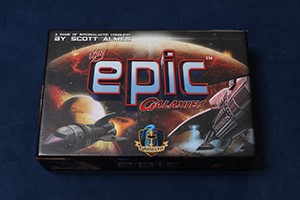
“Games that are small, quick to play, and easy to teach but that specifically offer a big box experience.” This was the goal of the Tiny Epic series of games according to Michael Coe, founder of Gamelyn Games, and one that the second game in the series, Tiny Epic Galaxies, has fulfilled time and again at our board game table.
No joke – the entirety of this game fits in a 7″ long x 5″ wide x 2″ deep box, and its expansion, “Tiny Epic Galaxies: Beyond the Black follows suit, meaning it delivers big fun without taking up big space on your shelf.
So how did Gamelyn Games put such a great game in such a small package? Let’s take a look at the rules and see if the game’s design offers any clues. Or you can watch us play a game of it in the video below!
How To Play Tiny Epic Galaxies
Player Count: 1-5
Estimated Play Time: 30-45 minutes
Tiny Epic Galaxies Rules PDF
Beyond the Black Rules PDF
Drones Rules PDF
Tiny Epic Galaxies and Beyond the Black Rules PDF
Since the gameplay of Tiny Epic Galaxies is a little different depending on whether or not you use the Beyond the Black expansion, I’ll cover the setup for the core game first, then explain what the expansion adds, and finally repeat the process for discussing gameplay.
If you’re only playing the base game, feel free to skip the Beyond the Black sections, as you will not use or need that information without the expansion.
Tiny Epic Galaxies Setup
Let’s start with a quick look at the pieces in our box (also found on page 2 of the base game’s rulebook.

To begin, each player receives:
- 1 Galaxy Mat (Available in Red, Green, Blue, Yellow, or Black)
- 4 Ships, 1 Empire Token, 1 Energy Token, and 1 Culture Token, each matching the color of their Galaxy Mat
- 2 Secret Mission cards
Each player puts 2 of their ships in their galaxy, then puts the other two on the square 3 and 4 spots of the ship track. Everyone also starts with 1 Culture and 2 Energy, and places their Empire Token on the star space of their Empire track.
The pictures below will show you all the pieces you should have and where they will be placed on your Galaxy Mat.

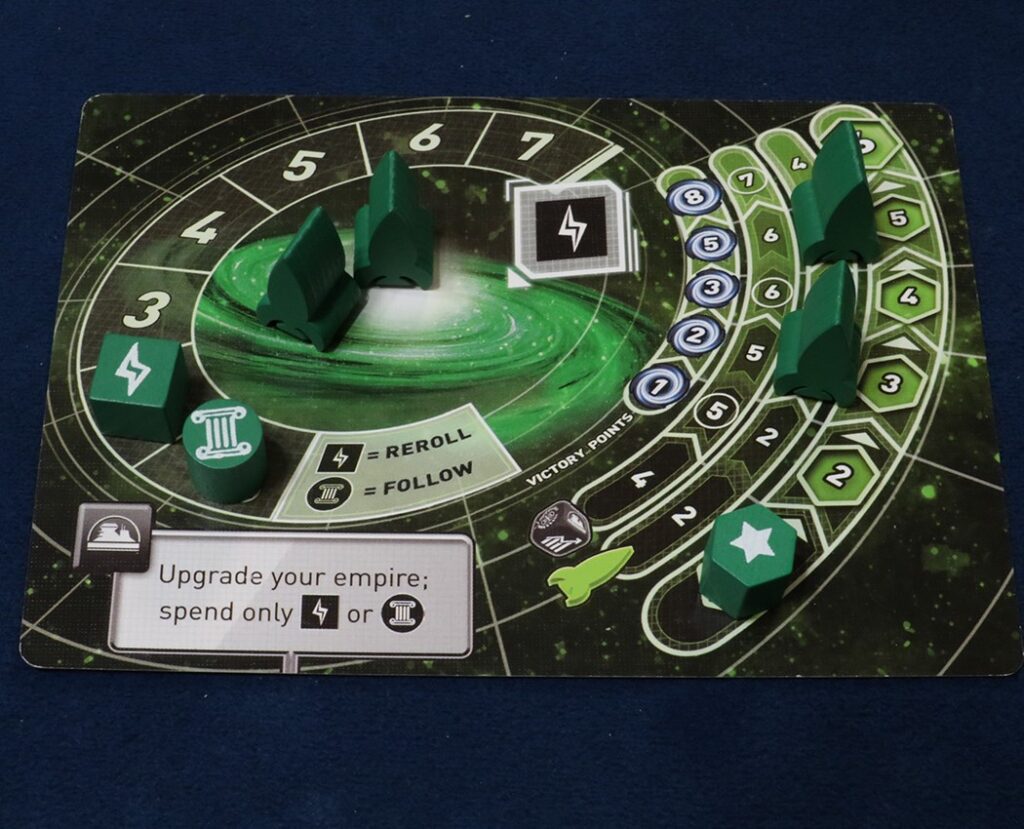
Next, someone will need to shuffle the Planet deck, then draw and place a number of Planet cards face up in the center of the table, depending on the number of players:
- For 2 players, reveal 4 Planets
- For 3 players, reveal 5 Planets
- For 4 or 5 players, reveal 6 Planets
Place the Control Mat and 7 Action Dice within easy reach of all players, and then have everyone look at their Secret Mission cards. Each player will select one of the two they were dealt to keep and place it under their Galaxy Mat, discarding the other. All Secret Mission cards reviewed should be kept secret from all other players.
Either have the youngest player go first or choose a different way to determine who starts, and you’re ready to play!
If you’re playing with the Satellites & Super Weapons mini-expansion included with either the Kickstarter or Tiny Epic Galaxies Deluxe Edition, shuffle the 6 Super Weapons and place them face down next to the Planet deck. At the start of the game, reveal the top Super Weapon card and place it on the center of the table.
Each player also takes 3 Satellites, and places them on their Galaxy Mat’s dice track on the spaces where numbers are outlined with circles.
Beyond The Black Setup
A new box means new components, so let’s take a look at what’s in Tiny Epic Galaxies: Beyond the Black (also listed on page 2 of the Beyond the Black rulebook).

Add the new Planet cards to the Planet deck and the new Secret Missions to the Secret Mission deck, then set up just as you would for the base game of Tiny Epic Galaxies.
In addition to the Galaxy Mat, Ships, and tokens each player receives from the original game, give them a Score token matching their color, a Hangar Mat, and the 4 Advanced Ships matching their color from the expansion. Everyone should place their advanced ships in the matching places on their Hangar Mats.
Once that’s done, someone should shuffle the Pilot deck, then draw and place a number of Pilot cards face up in the center of the table, above the row of Planet cards. As with the Planets, the number of Pilots revealed varies depending on the number of players:
- For 2 players, reveal 4 Pilots
- For 3 players, reveal 5 Pilots
- For 4 or 5 players, reveal 6 Pilots
Place the Exploration Mat within easy reach of all players, shuffle the Exploration deck, and place it on the Exploration Mat. Leave enough space near the Exploration Mat for up to 3 Exploration cards to be face up.
Finally, put the Scoring Mat where everyone can see it, and put each player’s Score token (blank side up) on the 0 space. You can flip a player’s Score token over to the + side to show that they have 30+ points later in the game.
When you’re done, your setup should look something like the picture below (also found on Page 3 of the rulebook). As you can see, this game is set up for 3 players.
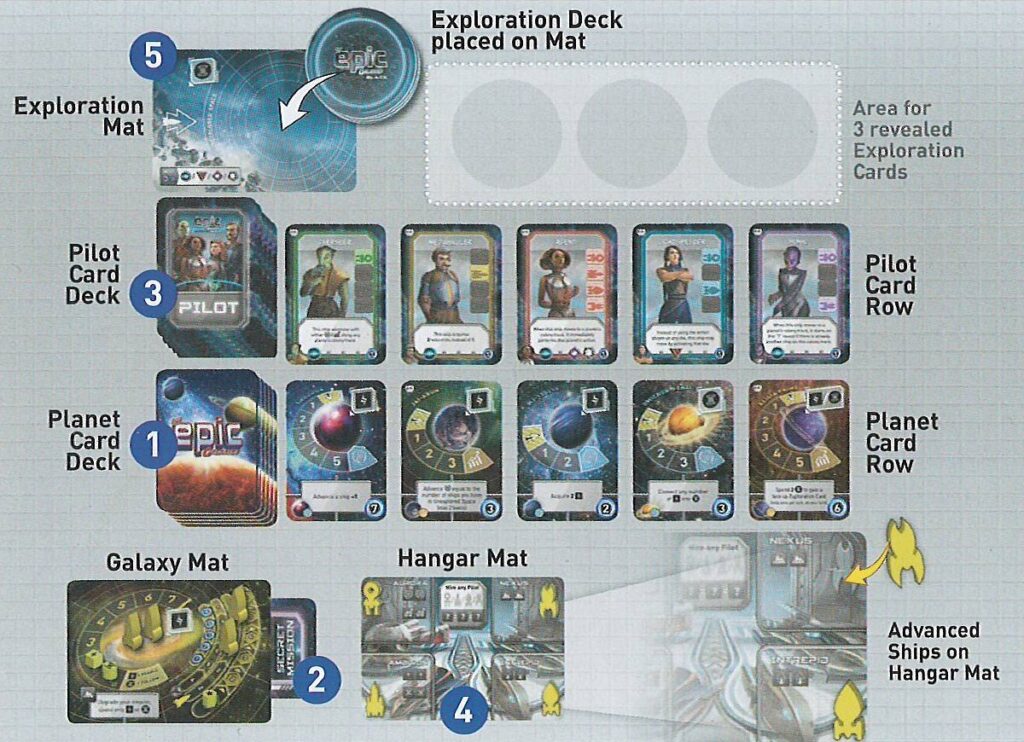
If you are playing with the Drones mini-expansion (included in Beyond the Black – Deluxe Edition, place the Factory card next to the PIlot deck, then put 4 Drone tokens on it for each player.
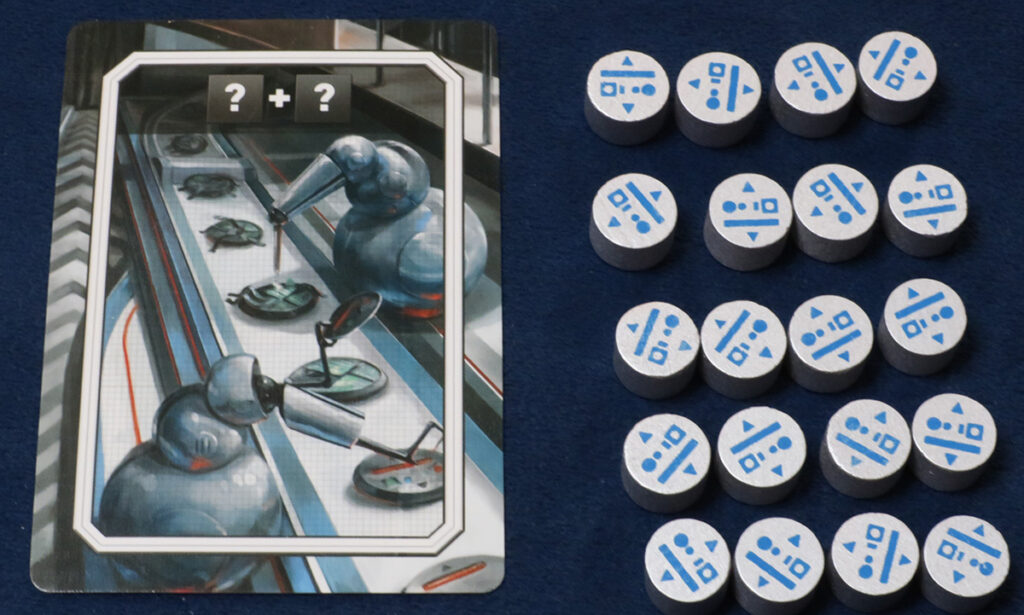
Tiny Epic Galaxies Gameplay
At the start of your turn, you’ll take the Control Mat and a number of Action Dice corresponding to your Empire’s level and roll them. If you’re the first player, this means you’ll have 4 dice to roll, but can gain more per turn as your Empire levels up.
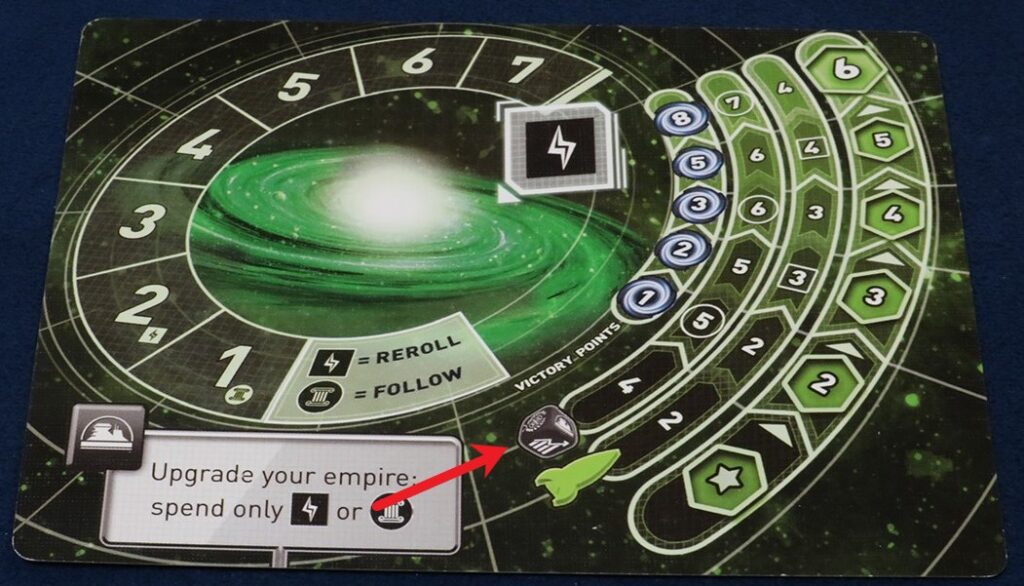
The results of your dice determine the actions you’re able to take on your turn. Each die has 6 unique faces you can roll with its own abilities, as pictured and described below.

- Move A Ship: Move a ship from its current location to another planet or your Galaxy Mat. If moving to a planet, it must be an entirely different one than your ship is currently orbiting or on the surface of (see below or page 5 of the rules for additional movement guidelines).
- Culture: Add 1 Culture to your Galaxy Mat for each ship orbiting or on the surface of a planet with the Culture symbol in the upper right corner (You may never have more than 7 Culture at 1 time).
- Energy: Add 1 Energy to your Galaxy Mat for each ship orbiting or on the surface of a planet with the Energy symbol in the upper right corner (You may never have more than 7 Energy at 1 time). Ships in your galaxy also generate Energy.
- Economy: Select 1 of your ships orbiting a planet with the Economy symbol on its track and move it forward 1 space.
- Diplomacy: Select 1 of your ships orbiting a planet with the Diplomacy symbol on its track and move it forward 1 space.
- Utilize A Colony: You may either choose to upgrade your empire by one stage or you the action of a planet you have colonized by completing its orbit track.
While these actions cover the basics of what you’ll need to know when resolving your dice, a few of these actions and resources offer additional benefits that may influence your decisions when determining which dice to keep.
Move A Ship
Moving ships is a key part of Tiny Epic Galaxies’ gameplay, as it can either initiate your ability to colonize a planet or let you take advantage of an uncolonized planet’s ability.
Colonizing a planet is pretty straightforward. Choose a planet you don’t have a ship already orbiting and lay it down on the first space of the colonization track. Then, depending on whether the track has an Economy or Diplomacy symbol, you can spend those dice to advance along that track.
When your ship reaches the end of a planet’s orbit track, you colonize it, claiming both the points it is worth as well as exclusive access to its ability for the low price of a Utilize A Colony die.
Sometimes a planet’s ability is worth using before you’ve even conquered it though. The Move A Ship action can move one of your ships to the surface of a planet that doesn’t already have one of your ships on its surface. You then get to use that planet’s action immediately. To use it again, however, you’ll need to leave and come back.
You may have 1 ship in orbit and on the surface of the same planet at the same time as well, so if there’s a planet you really need, you can work toward colonization while getting a head start on what it has to offer.
Note that nothing is stopping your opponents from hanging out on the same planets and orbits you are though, so take care not to dawdle with colonization!
If a planet gets colonized, any of your ships still in orbit or on the surface return to your Galaxy Mat. You also may not move to someone else’s Galaxy Mat. Finally, while it is usually not a good move, you may always choose to move a ship from a planet back to your Galaxy Mat with the Move A Ship action.
Follow Another Player Or Upgrade Your Empire With Culture
Culture serves two extremely important functions in Tiny Epic Galaxies. First, spending 1 Culture lets you follow another player’s die. Arguably the most powerful and strategic action in the game, this lets you use the same action an opponent who spent a die just used.
If multiple people followed the same action, resolve these actions starting from the current turn player’s left and proceed clockwise. No more than 1 Follow Another Action move may be performed per die, but that single action might be what lets you colonize a planet ahead of a rival or upgrade your empire for an extra die before your turn, so choose your moments wisely.
Culture may also be used to upgrade your empire by 1 stage via the Use A Colony action. Your empire always starts at level 1 (the star on the rightmost track). To level up your empire, you’ll need to spend an amount of Culture OR Energy (no mixing and matching) equal to the next level on your card.
So to move to level 2, you’ll spend 2 Culture, to level 3 you’ll spend 3 Culture, and so on up to the maximum level of 6. As your empire levels, you’ll get access to more dice on your turn, additional ships, and even victory points, so you can get quite a bit out of leveling a few times.
Reroll Dice Or Upgrade Your Empire With Energy
Sometimes, the dice just don’t go your way, even after using the free reroll of unwanted, unspent dice you receive each turn. For the low cost of 1 Energy, however, you can get an additional reroll, and can keep spending Energy in this way as long as you have it to spend.
Energy is also the other resource you can use to level up your empire – everything I had to say about this in the previous Culture section applies here as well. Spend a Utilize A Colony die and the requisite Energy for your next level, and you’re good to go.
Converting Dice
If you don’t have the Energy to reroll dice, you do have one last resort to get the action you want – the Converter on the Control Mat.
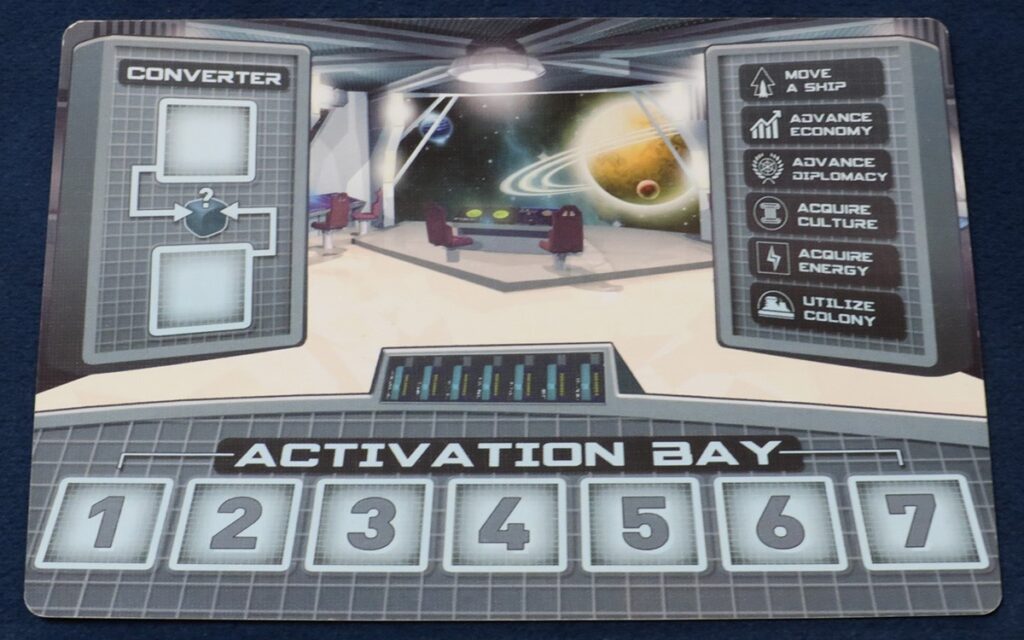
Once per turn, you may spend 2 unused dice to convert a 3rd unused die into whatever action you want. Your opponents cannot follow the first 2 dice, but may follow the 3rd as normal. This is extremely inefficient, and generally something I only use if I’m trying to end the game, but sometimes you’ve gotta do what you’ve gotta do.
Satellites And Super Weapons
If you are playing with this mini-expansion, you receive a Satellite from your dice track when you upgrade your Empire to levels 2, 4, and 6. This Satellite is then placed on the surface of an uncolonized planet, and is claimed by the player who Colonizes the Planet, who puts it in their Galaxy.
At the end of the game, Satellites in your Galaxy are worth 1 bonus point each, but do not count toward the 21 needed to trigger the end of the game.
Super Weapons can be interacted with in 2 different ways. First, by using the Move A Ship action, you can place one of your ships in its orbit as though you were going to Colonize a Planet.
Once you use Economy or Diplomacy to advance your ship to the end of its track, you pay 2 victory points, gain 1 Energy for each Satellite on the Super Weapon’s surface, destroy the Super Weapon, place it face down next to your Galaxy Mat, and reveal a new one.
If you have acquired a Satellite by Colonizing a Planet, you may also choose to place it on a Super Weapon to use its ability. This does not have to be done immediately and does not take an action, but must be done during your turn.
Winning Tiny Epic Galaxies
The end of the game is triggered when someone reaches 21 victory points (not counting Secret Missions). The current round finishes so all players have taken the same number of turns, then Secret Mission cards are revealed. Those who have completed their Secret Mission add those points to their total, and the player with the most points wins!
In the event of a tie, follow tiebreakers in this order:
- The player with the most colonized planets wins
- If still tied, the player with the highest Galaxy level wins
- If a tie is still present, the player with the highest combined total of Energy and Culture wins
If the leading players are still tied at this point, congratulate them on their co-victory!
Beyond The Black Gameplay
Beyond the Black uses all the same rules for gameplay as Tiny Epic Galaxies, but adds two additional actions:
- Hiring Pilots and replacing ships with Advanced Ships
- Moving ships into Unexplored Space and Exploring
Both of these new actions have some neat benefits worth exploring, so let’s go over them.
Hiring Pilots And Upgrading To Advanced Ships
To upgrade a ship, you begin by hiring a Pilot. This can be done one of two ways:
- Spend 2 matching dice corresponding to a ship the Pilot is trained in (see below for which dice can be spent on each Advanced Ship)
- Spend any 3 matching dice for any ship, even one the Pilot is not trained in
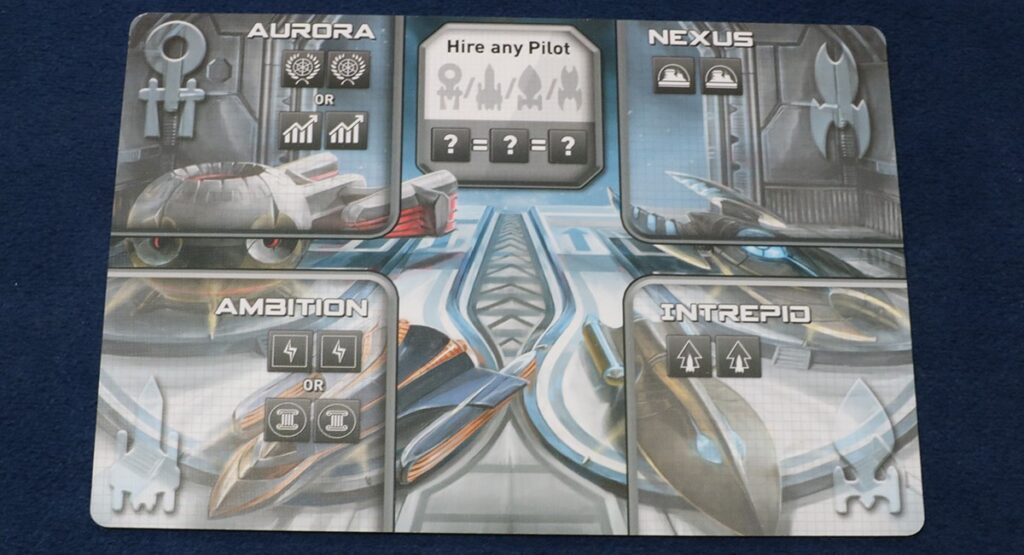
While there are no unique abilities inherent to a specific Advanced Ship, assigning a Pilot to one replaces one of your regular ships in its current location. Place the regular ship on the Pilot card on the space for the ship the Pilot is crewing, and now that Advanced Ship will have access to your Pilot’s ability, regardless of whether they were trained for the ship or not.
As with dice spent on the Converter, you may not follow the action of any dice spent to hire a Pilot.
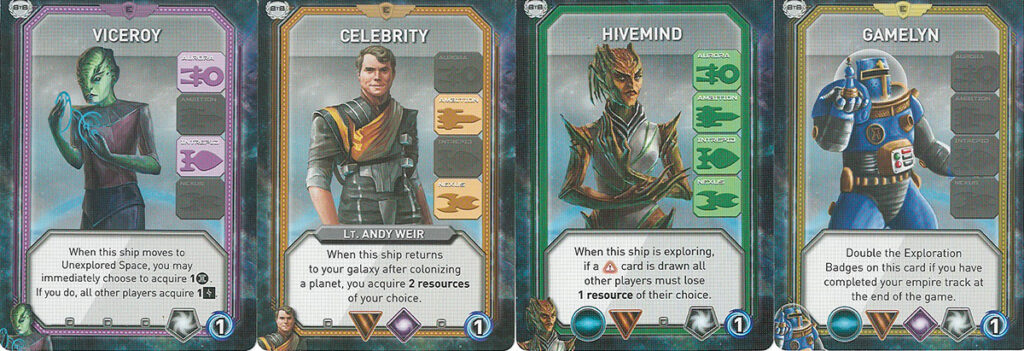
Pilots are worth 1 point each, and each Advanced Ship can only be piloted by 1 Pilot at a time. You may hire a replacement Pilot for a ship that already has a Pilot, but your Advanced Ship will lose the previous Pilot’s ability and any access to it for the rest of the game (though the Pilot is still worth a point and their Exploration Badges still count).
Speaking of Exploration Badges, a Pilot can have up to 4 unique badges, displayed at the bottom of their card. At the end of the game, each player that has the most of a specific Exploration Badge symbol receives 2 bonus points, and players with the 2nd most of a symbol (exempting 2-player games) receives 1 bonus point.
In the case of a tie for first, all tied players receive 1 bonus point, and no bonus points are awarded for 2nd. If there is a tie for 2nd, all tied players receive 1 bonus point.
This makes these 4 badges pretty important, as collecting a lot of them can award you up to 8 extra bonus points at the end of a game. Pilots aren’t the only source of these nifty baubles though – you can also get Exploration Badges by, well, exploring!
Exploring Unexplored Space
Unexplored Space is a new location you can send a ship to by using the Move A Ship action.
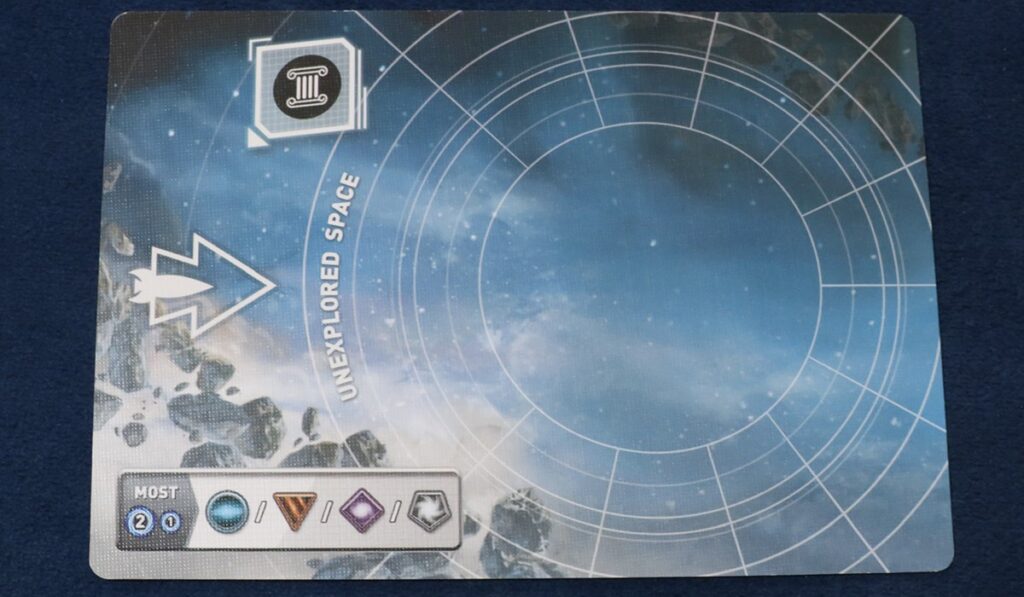
As you might have noticed, ships here can collect Culture with a Culture die, which is a very welcome addition after spending more than few base games glaring at a series of Energy Planets.
More importantly though, a ship that lands in Unexplored Space is required to explore it. This can be done one of 2 different ways:
- By taking one of the revealed Exploration cards (Remember, a maximum of 3 can be available at one time)
- By drawing a card from the top of the Exploration Deck (you MUST do this if Exploring and there are no revealed Exploration cards).
The moment you take an Exploration card, your Exploration comes to an end. While taking an already revealed Exploration card fulfills this requirement, how exactly do Exploration cards get revealed? You don’t start with any at the beginning of the game, after all.
This is where drawing comes in. When you draw an Exploration card, if it’s Green, you have the choice of either taking it or putting it to the right of the Exploration Deck (assuming there’s room) and drawing again. If there isn’t an open space for an Exploration card when drawing one, then you automatically have to take the card you draw.
Think of these Green cards as discoveries, or even Dwarf Planets (though they don’t count for the purpose of totaling Colonized Planets)

Red cards, on the other hand, are hazardous Danger Cards. If you draw one, you are automatically forced to take it, penalizing you while also forcing Exploration to an end. While some will simply cost you Resources and be over with, others have tracks you must complete before you can collect the card – or your ship.
Worse still, a ship on a Danger Card’s track no longer counts as being in Unexplored Space, so no collecting Culture until you finish the hazard.
Once you collect an Exploration card, resolve its effect, then place it in a face down pile near your Hangar Mat. You can look at your Exploration cards, but information on them is kept secret from your opponents after the reveal until the end of the game.
As with landing on a planet, you have to leave and come back before being allowed to Explore again, or send another ship to Unexplored Space, as you can put multiple ships there.
Enhancing Your Pilots With Drones
If you are playing with the Drones mini-expansion, you may also hire a Drone token for any of your Pilots (as with Pilots, dice spent to hire a Drone cannot be followed). Each Pilot may only have a maximum of 1 Drone, and if you buy a replacement Pilot with a drone, the drone moves to the new Pilot.
At the end of the game, Drones are worth 1 point each and double the Exploration Badges of the Pilot(s) they are attached to. This is another great way to stack up some Exploration Badges and victory points with minimal effort, or even as a consolation prize for an otherwise unusable roll.
Tiny Epic Galaxies Strategy Tips
Now that we’ve covered all the nuts and bolts of how to play and win, it’s time to strategize! Here are a few helpful tips I’ve found to help me get ahead in Tiny Epic Galaxies.
Get Your Empire To Level 2, Then Level 3 ASAP
The second level of your empire gets you access to a 5th die on your turn, and you actually start with the necessary resources to make it happen on your turn or by following an opponent who is spending a die to Utilize A Colony.

This also gets you a victory point and within striking distance of a 3rd ship, the latter of which you’ll want almost immediately to give yourself options on later turns. Leveling up your Empire is almost always a great first move, and then working in another jump to 3 can usually be worked in among other moves with minimal trouble.
From here, levelling your Empire is still useful, but no longer has to be a top priority. The sooner you do it, the more time you get to use extra dice. The tradeoff is that you’ll fall behind a bit in Planet Colonization, so striking a good balance between these two things is generally what you want to shoot for rather than going all in on one or the other.
Pay Attention To Everyone’s Culture
Culture lets players follow the moves of the active turn player in Tiny Epic Galaxies, and the chess match it creates is effectively its own subgame within the main game. Is it worth it to try and use a Colonized Planet right away, or do you want to try and bait out some stored Culture by Moving A Ship first?
These types of questions only increase in importance as the game progresses, as you don’t want to give up on your game plan, but also want to be sure you’re getting the most benefit out of each die you spend on your turn.
This also means you’ll want to prioritize keeping a healthy stash of Culture for yourself so you can make moves while waiting for your next turn. Orbiting or landing on Culture planets to do this is especially attractive when playing without the expansion, as you don’t have access to Unexplored Space to build up your reserves.
Spend Dice Efficiently Where Possible – But Spend Extra When You Must
As someone who loves extracting the maximum amount of value out of moves when playing almost any game, I understand how painful it can be to use the Converter or spend an extra die on that Pilot you need.
But sometimes that isn’t going to be possible, and you need to be mentally prepared to pull that trigger the rare times you need to.
While this is obviously less of a problem if you’re playing the winning move, you also often have to consider whether it’s really worth spending that Energy on another reroll that might not help you, or whether you can really afford to give up that Planet you’re racing to Colonize.
Put another way – there’s no shortage of decisions available to you in Tiny Epic Galaxies. Just because a move looks bad on paper doesn’t mean it’s a bad call in practice, as long as you don’t make a habit of leaning on expensive choices throughout the game.
After all, the last thing you want to do is fall behind!
Remember You Get 1 Free Reroll Every Turn
Seriously. This can bail you out of trouble when your first roll contains nothing but garbage. If more rerolls are needed, you can also spend 1 Energy per reroll beyond the first, which can also be very worth it in many scenarios.
Try to have more than result you can use in mind when spending Energy this way though – 1 in 6 isn’t great odds.
Quickly Colonize Planets You Need For Your Strategy
Whether a planet is worth 1 point or 7, if it has a relevant ability that ties in well with your game plan, get it Colonized ASAP! Colonizing planets is not only good for points, but it gives you exclusive access to their abilities, which opens up more choices on your turns (or when following your opponents).
Just be mindful of the fact that some Planets let players use the abilities of their opponents’ Planets, so this can also be a good way to open up access to abilities you need when these cards show up.
Don’t Ignore Pilots Or Exploration Badges In Beyond The Black
As with the Planet advice, if you’re playing with the Beyond the Black expansion, get the Pilots you need ASAP as well – the last thing you want to do is miss out on an ability that makes your life easier.
You also don’t want to skip out on the points Exploration Badges can reward you with – these can represent a substantial swing at the end of the game, even if you weren’t the one who made it to 21 first!
Tiny Epic Galaxies Variants
While the multiplayer experience we’ve discussed up to this point tends to be the primary way to experience Tiny Epic Galaxies, there are a few gameplay variations and add-ons that can change things up a little if you’re looking for a different twist on the standard.
The Rogue Galaxy
The Rogue Galaxy is Tiny Epic Galaxies‘ solo play variant, and it utilizes the back sides of the Galaxy Mats from the base game. Unlike the normal Galaxy Mats, whose differences are purely cosmetic, the Rogue Galaxy Mats actually correspond with different difficulty levels! They are:
- Blue is the Artemis Galaxy, beginner difficulty
- Yellow is the Rothkel Galaxy, easy difficulty
- Green is the Zendica Galaxy, normal difficulty
- Red is the Hades Galaxy. hard difficulty
- Black is the Gamelyn galaxy, epic difficulty

Setup works the same as a 2 player game with just a few changes:
- Pick a Rogue Galaxy Mat to be your opponent
- The Rogue Galaxy starts with no Culture or Energy, but has access to all 4 of its ships
- No Secret Mission cards are dealt
- You always go first
On the Rogue Galaxy’s turn, it rolls one die at a time, resolving its action before rolling its next die. It never follows your dice (though you can still follow its dice), and its actions also work a little differently:
- Move A Ship: Move a ship from the Rogue Galaxy Mat to the orbit of the leftmost planet it isn’t orbiting. It never lands on a Planet’s surface, and this action does nothing if there are no ships remaining in the Rogue Galaxy.
- Culture: Add 1 Culture to the Rogue Galaxy for each ship in the Rogue Galaxy or orbiting a Culture Planet.
- Energy: Add 1 Energy to the Rogue Galaxy for each ship in the Rogue Galaxy or orbiting an Energy Planet.
- Economy: Advance all Rogue Galaxy ships orbiting planets with Economy tracks 1 space.
- Diplomacy: Advance all Rogue Galaxy ships orbiting planets with Diplomacy tracks 1 space.
- Utilize A Colony: Use the red action box corresponding to the Rogue Galaxy’s current Empire level as an attack against you. If that attack says it can be used only once per turn, all further Utilize A Colony results do nothing. The Rogue Galaxy never uses the action of a Colonized Planet.
If the Rogue Galaxy’s die roll would result in an action that has it do nothing, it gets a second chance to try and roll for a usable result. If its result still isn’t usable, the die fizzles and is discarded. You can also force the Rogue Galaxy to reroll a die by spending 1 Culture and 1 Energy as many times as you can afford.
Finally, if the Rogue Galaxy reaches its maximum Culture or Energy, it gets to take a special action at the end of its turn:
- Culture: The Rogue Galaxy takes an additional turn with 3 dice. This cannot be done on back to back turns.
- Energy: Upgrade its empire, then reset its Energy back to 0. This can only be done once per turn.
The Rogue Galaxy automatically wins if it reaches 21 victory points or upgrades its Empire to the skull and crossbones at the end of its Empire track. You automatically win when you reach 21 victory points.
Tiny Epic Galaxies Blast Off
Tiny Epic Galaxies Blast Off is designed as a more streamlined version of Tiny Epic Galaxies, complete with a few rule changes designed to simplify gameplay. Secret Missions have been removed, there are limits to how Following Actions works, and the game only supports 2-4 players instead of 1-5, to name a few.
While this is anecdotal, the research I did on this revised version indicates reception was pretty lukewarm. There’s simply less nuance to much of the base game, and the reduce options for player count were poorly received. Most recommend the original Tiny Epic Galaxies release as the better game, even if Beyond the Black‘s added complexity is pretty divisive among fans.
Ultra Tiny Epic Galaxies
Ultra Tiny Epic Galaxies is the same great game as the original, complete with Satellites & Super Weapons, but fits in your pocket. What’s not to love?
Is Tiny Epic Galaxies Worth Playing?
Emphatically yes! Tiny Epic Galaxies takes up very little space on your shelf, has lots of additional rulesets you can mix and match into the base gameplay to keep it from getting stale, and there are always plenty of options open to you – even when it’s not your turn!
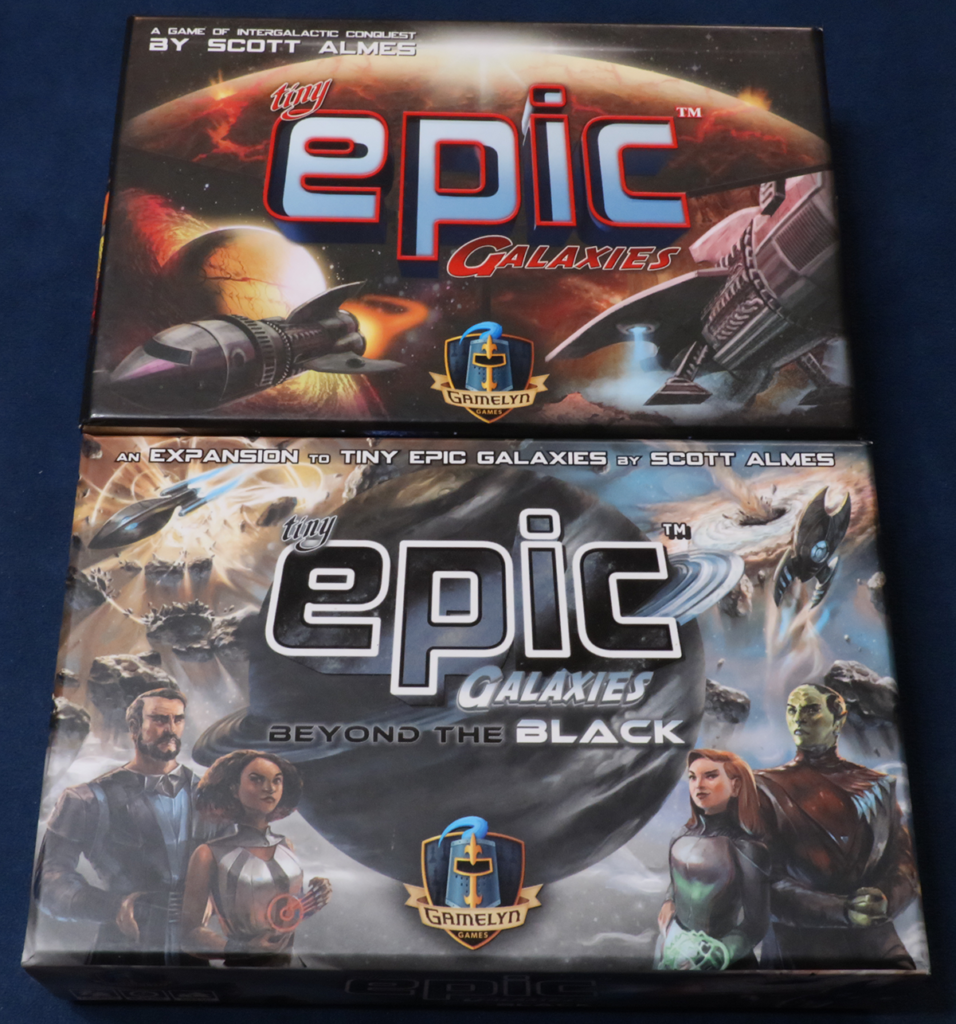
That said, while Beyond the Black is interesting, I don’t feel that it is a “must have” expansion. Pilots and Exploration Badges are interesting ways to open up new strategies, but I find that I already have a lot of choices to navigate in the base Tiny Epic Galaxies game without adding more potential moves to consider.
Its mechanics certainly aren’t bad though – I do recommend it for veterans of Tiny Epic Galaxies who want to add that extra layer of depth to board game nights.
Don’t start newcomers to the game off with it though; letting them get their feet wet and wrapping their head around the base game’s mechanics first makes the learning curve manageable, if a little steep.
Adding in Pilots, Drones, Exploration, and even Satellites & Super Weapons is a good way to make things too confusing to keep track of if they’re all introduced at the same time. Even without all of that though, the box certainly delivers what it promises, which will make it much easier to hook your friends on the game and convince them to try out these other nuances of gameplay.
Board Game Articles You’ll Love:
- How To Play CuBirds
- Cindr Board Game Strategy Guide
- Take 5 Rules
- Bunny Kingdom Rules
- 7 Wonders Strategy
- Blokus Game Rules
Braden is a founder of Assorted Meeples and has been a gamer & writer with a vivid imagination all his life. Don’t believe us? Check out his excitement when meeting Goosebumps author R.L. Stine as a kid! An avid Magic: The Gathering spellslinger for over 15 years, you can always convince him to shuffle up for a game (or three!) of Commander.
